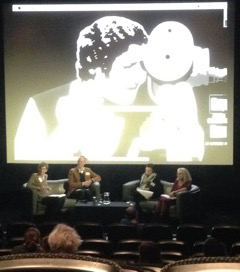Search Databases
Access Records From Our Distinctive Collections
Doing Women’s Film and Television Histories III Conference
Cover image: Ada Hakeney on camera, BBC Leeds, circa 1972 (c) Joe Hakeney
The central theme of this third conference was 'Structures of Feeling,' derived from the work of Raymond Williams on social change, and commemorated the 40th anniversary of the 1975 publication of Patterns of Discrimination Against Women in the Film and Television Industries by the Association of Cinematograph, Television and allied Technicians (ACTT) union’s Committee of Equality. Such reports are invaluable because they identify the ways in which women’s work in ‘below-the-line’ roles have been undervalued as well as highlighting the policies, practices and assumptions of the industries that keep gendered hierarchies in play. Crucially they also make visible the largely ‘invisible labour’ of cinema and television that is carried out by women.
While these 'jumping-off' points explore women working in UK production contexts, Doing Women's Film & TV History III, like its predecessors, was international in scope and the conference explored the ‘structures of feeling’ of women working in different national system of film and television production across diverse historical periods. The conference also addressed the various critical and historiographic tools that can be utilised to bring women’s ‘structures of feeling’ in film and television history to view.
- Explore the conference programme (opens pdf document)
- Read Jenny Brownrigg’s conference report (opens new web page)
- View photos from the conference (opens Facebook page)
Keynote conference papers (selective)
Miranda J Banks
Room at the Top: Women’s Work and Working Women in Film and Television
Shelley Cobb and Linda Ruth Williams
Calling the Shots: Constructing Histories of Contemporary Women Filmmakers in the UK
Michele Hilmes
Gender and Seriality: A Reconsideration
